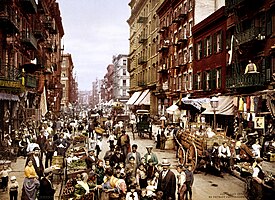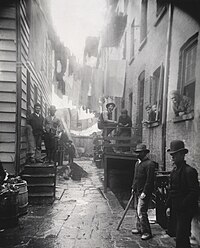Mulberry Street (Manhattan)
Mott Street | |
| West | Baxter Street |
|---|---|

Mulberry Street is a principal thoroughfare in
The street was listed on maps of the area since at least 1755. The "Bend" in Mulberry, where the street changes direction from southeast to northwest to a northerly direction, was made to avoid the wetlands surrounding the
Mulberry Bend, formed by Mulberry Street on the east and Orange Street on the west, was historically part of the core of the infamous Five Points; the southwest corner of Mulberry Bend formed part of the Five Points intersection for which the neighborhood was named. Aside from Mulberry, the other four streets forming Five Points were Anthony Street (now Worth Street), Cross Street (now Mosco Street), Orange Street (now Baxter Street), and Little Water Street (which no longer exists).[2]
Location
Mulberry is located between Baxter and
Further south past Bayard Street, on the west side of the street, lies Columbus Park, which was created in 1897.[4] The southwest corner of the park (away from Mulberry Street) is the site of the original Five Points intersection. The east side of the street is now lined with Chinatown's funeral homes.[citation needed]
Mulberry Bend

The street was named after the
For the urban reformer Jacob Riis, Mulberry Bend epitomized the worst of the city's slums: "A Mulberry Bend Alley" contrasted with "Mulberry Bend becomes a park" were two of the photographs illustrating Jacob Riis's call for renewal in The Battle with the Slum (1902).[7] In response to reformers such as Riis, the city in the 1890s bought out many of the slumlords and replaced tenements with Columbus Park.[8]
Notable buildings
The
The Italian American Museum is at 155 Mulberry and Grand Street in the building that used to house the Italian immigrant bank Banca Stabile.[9][10][11][12]
-
Black Horse Tavern Mulberry And Park St.
-
Saint Patrick's Old Cathedral(1815)
-
St. Philip's Church, Mulberry St.
Culture
Social structure
The New York Times sent its reporters to characterize the Little Italy/Mulberry neighborhood in May 1896:
They are laborers; toilers in all grades of manual work; they are artisans, they are junkman, and here, too, dwell the rag pickers....There is a monster colony of Italians who might be termed the commercial or shop keeping community of the Latins. Here are all sorts of stores, pensions, groceries, fruit emporiums, tailors, shoemakers, wine merchants, importers, musical instrument makers....There are notaries, lawyers, doctors, apothecaries, undertakers.... There are more bankers among the Italians than among any other foreigners except the Germans in the city.[13]
-
Children sleeping in Mulberry Street (1890)
-
Produce stand on Mulberry Street
-
Tai Chi practiced on Mulberry Street
-
Feast in Little Italy on Mulberry
Feast of San Gennaro

During the
In popular culture
Manhattan's Mulberry Street has been the subject of books, films, and music. For example:
- Books
- The King of Mulberry Street, by Donna Jo Napoli. A young boy in the 1890s travels alone from Napoli (Naples), Italy to New York, where he settles on Mulberry Street.
- Music
- Billy Joel's song "Big Man on Mulberry Street" is a jazz-influenced song from his album The Bridge (1986).[14]
- Twenty One Pilots' "Mulberry Street" from their album Scaled and Icy.
References
- ^ Staff (April 1, 1896). "Abattoirs; History of New-York Slaughter-Houses — Interesting and Curious Data" (PDF). The New York Times.
- ISBN 978-0-300-11465-2., p.456
- ^ Chin, RK. "A Journey Through Chinatown: Mulberry Street". RK Chin Web Gallery. Retrieved April 16, 2015.
- ^ "Columbus Park". New York City Department of Parks and Recreation. Retrieved October 27, 2007.
- ^ Naureckas, Jim. "Mulberry Street: A New York Songline". New York Songlines. Retrieved April 16, 2015.
- ^ Logan, Harlan (1894). "The Bowery and Bohemia". Scribner's Magazine. p. 458.
- ^ Max Page devotes a section to "Jacob Riis and the 'leprous houses' of Mulberry Bend" in The Creative Destruction of Manhattan, 1900-1940, 2001:73ff
- ISBN 9780549437819.
- ^ In Little Italy, a Former Bank Will Now Hold Italian Immigrants' Memories, The New York Times, September 8, 2008
- ^ Warerkar, Tanay (2018-01-17). "First look at Little Italy's revamped Italian American Museum". Curbed NY. Retrieved 2021-10-23.
- ISSN 0362-4331. Retrieved 2021-10-23.
- ^ "Home". Italian American Museum. Retrieved 2021-10-23.
- ^ Staff (May 31, 1896). "Little Italy in New-York". The New York Times. p. 32.
- ^ "Billy Joel, AXS TV, Jazz Fest Release 'Big Man On Mulberry Street' Performance". BillyJoel.com. May 20, 2013.
Further reading
- Frunza, Bogdana Simina (2008). Streetscape and Ethnicity: New York's Mulberry Street and the Redefinition of the Italian American Ethnic Identity.
- JSTOR 25144462.
- Pozzetta, George E. (1979). Harney, Robert F.; Scarpaci, J. Vincenza (eds.). "The Mulberry District of New York City: The Years before World War One". Little Italies in North America. Toronto: The Multicultural History Society of Ontario. pp. 7–40.
External links
- New York Songlines: Mulberry Street, a virtual walking tour
- Mulberry Street Storefronts - photographs of buildings and stores along Mulberry St from Chinatown through Little Italy
- "Mulberry Street, New York City". World Digital Library. 1900.







